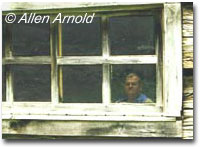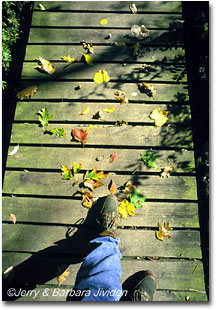|
|
 Insights on Images
All rights reserved. Be a Better ViewFINDER
This impediment can strike any one of us--at any income level, in any geographic region, at any time. Some call it "creative block," we prefer to recognize it for what it really is, a poor "viewFINDER." No need to call the manufacturer. It's not the one on your camera! Even though you will find it within the core of your creativity, you can learn to stretch and exercise this internal "viewFINDER" as if it were a muscle ready to be toned and strengthened. During many of our photographic workshops, we set the stage for a rigorous mental workout. First, we ask that while photographers are in the field, they attempt to take three different shots of every subject they photograph (and this can be extremely challenging when photographing wildlife). While this non-traditional method of instruction may seem like a game, it is actually the warm-up for the real exercise. Of course, when the workshop schedule permits, we spend orientation time with photographers before going into the field. This is to help them better understand the photography basics (or ensure that they already have that knowledge). It is important to have a good understanding of the camera and manual metering (even those who prefer to use a "program" mode of operation). Once photographers comprehend how and why their camera's light meter is determining the suggested settings or values, they can then advance to changing those settings to accomplish different results and still maintain perfect exposure. This important process is known as equivalent exposure. Next, we suggest several compositional techniques and explain the subsequent benefits of each. In short, these are simple (yet, important) rules that are often taught in basic art classes (even at high school level). If you choose to alter or modify one of these so-called rules, fine--but be prepared to tell why. 
Most of these principles share some commonalties, such as composing the shot using the "rule of thirds." Note: The "rule of thirds" can be seen by mentally dividing a picture into three even sections wide by three even sections high. Doing so can help you to understand the concept. In the strongest compositions, the subject is not in the direct center.) Once everyone is ready, we set the plan into motion. We call it the "ViewFINDER Scavenger Hunt." Each item on a list of 10 is carefully selected to hone the photographers' critical thought process. We know that regardless of equipment, film types, or fancy field accessories, photographers must find the pictures that beckon to be captured on film. While subject matter is important, good nature photographers must make the best out of earth's ever-changing conditions and scenes. "Be a better viewFINDER," we say. "Really look for the pictures that Mother Nature hides, nestles, or covers." Next, we remind our workshop participants, "The camera only takes the picture, but the photographer makes the picture." Following our encouragement and a natural drive, the determined photographers aggressively seek to conquer "the list." Just one session at the light table after film processing will reward those who worked hard and mastered the challenge. In a way, the photographers who really push their limits will not only learn to better photograph nature, but they will put wings on their imagination. As we always conclude, "No one is ever limited when he tries. It is when trying ends that limitations begin." Below is a copy of our "ViewFINDER Scavenger Hunt." Try these on your next photo adventure! 
(*Note: We have seen cleverly staged self-portraits ranging from reflections to silhouettes and double-exposures!) About the images... PHOTO OF FEET ON A PATH: With a 17mm lens, Jerry was able to take a photo of his own feet on this boardwalk. He has sold this "unusual perspective" shot several times for usage in travel planners and visitors guides. It was easy to do and didn't require having a second person to pose. PHOTO OF FERN: Patterns in nature can be found almost anywhere. After you develop the art for seeing such patterns, you can work on pleasing compositions. As mentioned, we shot this fern three different ways to help stretch our imagination. This final image was one where we sprayed a fine mist of water on the plant for "dew" effect. PHOTO OF WINDOW: Allen Arnold, a recent workshop participant in the Smoky Mountains, created this clever self-portrait with the assistance of a "spotter," who looked through Al's viewfinder to see if he was positioned for best placement between the windowpanes. Al even held a reflector himself to add highlights to his face. JJ/BJ-NPN Jerry and Barbara Jividen are members of the North American Nature Photography Association (NANPA) and the American Society of Media Photographers (ASMP). Barbara is also a member of the Outdoor Writers Association of America and serves as Assistant Editor for NANPA's Currents. Both are certified photography instructors and lead numerous photo workshops and tours throughout the year. They also write a monthly e-journal, called the "Insights on Images: E-Journal," which can be obtained via email by requesting a free copy at: www.imagesunique.com/insights/journal.html. For more information, call (800) 866-8655. |
|
|
 As serious nature photographers, most of us would agree that many of our limitations are not caused by a lack of great subjects in nature. While equipment and access are, of course, always going to be contributing factors to our rate of success or failure, another hindrance may be more formidable.
As serious nature photographers, most of us would agree that many of our limitations are not caused by a lack of great subjects in nature. While equipment and access are, of course, always going to be contributing factors to our rate of success or failure, another hindrance may be more formidable.